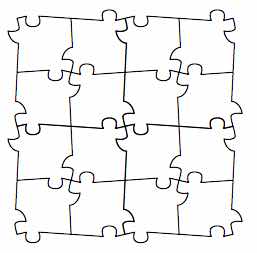A
previous post mentioned that 25 of the 28 Heesch types could be formed using only identical edges of central rotation. The other three can also be formed using edges of central rotation, but they require at least two sizes of edges. Edges formed with center-point rotation can serve not just as C edges in the Heesch classification of types but also as T, G, C3, C4, and C6 edges, that is, any type of edge.
Mirroring an edge formed with central rotation is equivalent to gliding it. Translating an edge that mirrors over its midpoint is also equivalent to gliding it. Hence, some edges that are translated or mirrored can be seen as glided. How many of the Heesch types can be formed with all edges that are glided whether or not the edge fits as a glided edge?
Glided edges have less flexibility than edges formed with center-point rotation partly because they must be paired and not all edges pair in types formed on triangular and pentagonal templates. The closest we can get to an all-glided version of a triangular type, for example, is shown below. Notice that it can satisfy the CGG type in two ways, but not three. This tiling satisfies CCC and CC6C6 as well as CGG.
However, all edges of quadrilateral and hexagonal types can have edges paired and all of these can be formed with edges that are glided. In constructing them below, I have used asymmetric edges when the edges serve as G edges in the Heesch type and whenever else they can be used. When the type calls for C edges, I have used an edge with center-point rotation and mirrored it. All other edges have mirror symmetry over their midpoints. When there two or more pairs of the same type, different shapes are used to differentiate them if it is possible.
Let us start with the two quadrilateral types that must be formed with glided edges, G1G1G2G2 and G1G2G1G2. Below is an example of G1G1G2G2 with matching pairs differentiated.
Next is an example of G1G2G1G2.
Some of the other quadrilateral types formed with glided edges also fit either G1G1G2G2 or G1G2G1G2. To form TGTG with only glided edges, the TT pair must be formed with reflective symmetry over the midpoint. It also fits type G1G2G1G2.
Type TCTC can be formed with glided edges if the TT pair of edges reflects over their midpoints and the CC pair of edges is identical and mirrors. The tile has symmetry over the translated edges and fits isohedral class IH66. It also fits G1G2G1G2.
The CGCG type has the CC pair of edges formed identically and mirrored rather than translated. Like the previous two, it also fits G1G2G1G2.
The CC edges can also be mirrored when they are adjacent, as this example of a CCGG type shows. The tiling also fits G1G1G2G2.
A CCCC type that uses glided edges can reflect over the diagonal and fit isohedral class IH69. It is type G1G1G2G2 formed with edges of central rotation.
Alternatively, the edges can mirror as opposite edges in which case it is also type G1G2G1G2.
Two of the eleven quadrilateral Heesch types can be formed with asymmetric edges that will simultaneously fit either G1G2G1G2 or G1G1G2G2. Isohedral class IH68 is simultaneously TTTT and G1G1G2G2. All edges are shaped identically and there is mirroring over one diagonal
Isohedral class IH71 can be seen as either G1G2G1G2 or as C4C4C4C4. All edges must be identically formed and there is mirroring over one diagonal.
An alternative way of getting a glided C4C4C4C4 tiling is with an arrangement that is simultaneously G1G1G2G2 and C4C4C4C4.
(By accident I discovered that this shape will tile anisohedrally.)
Finally, two of the eleven quadrilateral Heesch types can be formed with glided edges but the tilings are not G1G1G2G2 or G1G2G1G2. To form type C3C3C3C3 with glided edges, the edges must reflect over their midpoints.
The tile in the tiling above can be arranged in a G1G1G2G2 tiling.
As with type C3C3C3C3, to form type C3C3C6C6 with glided edges, the edges must reflect over their midpoints.
The tile can also be arranged in a G1G1G2G2 pattern as illustrated below.
Part two will consider the
hexagonal types.

















































